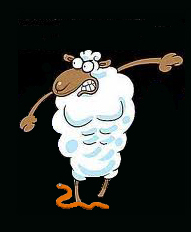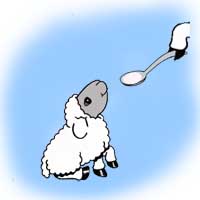Control Parasites
Sheep Select Diets To Control Parasites
 Tannins are secondary compounds produced by plants. Tannins reduce forage intake and protein digestibility but at the correct dose they may benefit ruminants by reducing the number of internal parasites. Most shrubs contain tannins as do sudangrass, birdsfoot and big trefoil, sorghum, sulla, sainfoin, and sericea lespedeza.
Tannins are secondary compounds produced by plants. Tannins reduce forage intake and protein digestibility but at the correct dose they may benefit ruminants by reducing the number of internal parasites. Most shrubs contain tannins as do sudangrass, birdsfoot and big trefoil, sorghum, sulla, sainfoin, and sericea lespedeza.
USU research assistant professor, Juan Villalba, and graduate student, Larry Lisonbee were curious if sheep infested with high levels of internal parasites would prefer to eat foods containing tannins when compared to sheep with low levels of internal parasites.
In the first study, lambs infested with parasites ate more of a supplement that contained tannins than lambs with low levels of parasites. This behavior continued as long as parasite levels in the infested lambs remained high. As the trial progressed, differences between groups became smaller and disappeared near the end of the study as parasite numbers in infested sheep declined.
During the second study, two groups of lambs with and without internal parasites were offered an alfalfa/tannin mixture. Intake and preference for the alfalfa/tannin mixture were not different between groups at the beginning of the trial or when parasite levels were low in both groups. When lambs were infested with parasites, they had a higher preference for, and ate more alfalfa/tannin than lambs with low parasites levels. When lambs infested with parasites ate the alfalfa/tannin mixture their fecal egg counts (a measure of parasite infestation) also decreased. There was a direct relationship between the amount of alfalfa/tannin eaten and the decline in fecal egg counts.
These studies suggest: 1) lambs can detect internal parasite infestations, 2) they can learn about the relationship between the flavor of tannin and relief from internal parasites and 3) tannins can reduce parasite levels.
References
- Villalba, J.J., F.D. Provenza, J.O. Hall and L.D. Lisonbee. 2009. Selection of tannins by sheep to gastrointestinal nematode infection. J. Anim. Sci.88:2189-2198.
- Lisonbee, L.D., J.J. Villalba, F.D. Provenza, and J.O. Hall. 2009. Tannins and self-medication: Implications for sustainable parasite control in herbivores. Behav. Process. 82:184-189.
Lambs Learn to Use Tannins to Combat Parasites
 Juan Villalba and his colleagues, studied how prior conditioning might affect intake of alfalfa with 10% tannin (AT) by lambs with high levels of parasites compared to lambs with low levels of parasites. Half of the lambs in the study were naturally infected with internal parasites and half had low levels of parasites. At the beginning of the study, lambs were offered a choice of alfalfa and AT. Regardless of parasite load, lambs ate very little of AT when given a choice between AT and plain alfalfa. Thus, lambs with high levels of parasites did not initially eat tannin.
Juan Villalba and his colleagues, studied how prior conditioning might affect intake of alfalfa with 10% tannin (AT) by lambs with high levels of parasites compared to lambs with low levels of parasites. Half of the lambs in the study were naturally infected with internal parasites and half had low levels of parasites. At the beginning of the study, lambs were offered a choice of alfalfa and AT. Regardless of parasite load, lambs ate very little of AT when given a choice between AT and plain alfalfa. Thus, lambs with high levels of parasites did not initially eat tannin.
Lambs were then fed AT for two hours per day for 5 days. After conditioning, lambs with high levels of parasites ate more AT, had a greater preference for AT, and ate less plain alfalfa than lambs with low levels of parasites. After lambs were treated with a commercial wormer and parasite loads were reduced, the two groups of lambs ate similar amounts of AT. Eating AT reduced fecal egg counts. Lambs that had higher preferences for AT also had lower fecal egg counts by the end of the trial.
The results suggest that exposing a ruminant with high parasite loads to certain foods enables them to learn about the medicinal benefits of those foods. The ability of ruminants with high parasite loads to self-medicate with secondary plant metabolites like tannins, may be an alternative to routinely treating animals with commercial wormers and may reduce the number of parasites resistant to commercial wormers.
References
- Villalba, J.J, F.D. Provenza, J.O. Hall and L.D. Lisonbee. 2010. Selection of tannins by sheep in response to gastrointestinal nematode infection. J. Anim. Sci. 88:2189-2198.
Lambs Learn to Take Their Medicine
 In the summer of 2009, graduate student, Udita Sanga, conducted a study to see if ewes can teach their lambs to eat polyethylene glycol (PEG) when eating a food high in tannins. PEG binds to tannins and lessens their harmful effects.
In the summer of 2009, graduate student, Udita Sanga, conducted a study to see if ewes can teach their lambs to eat polyethylene glycol (PEG) when eating a food high in tannins. PEG binds to tannins and lessens their harmful effects.
Before the trial began, one group of ewes was trained to eat a tannin-grape pomace diet. Another group was trained to eat PEG when eating the tannin-grape pomace diet. After ewes were trained, lambs were fed the tannin-grape pomace diet and PEG. They were offered the diet and PEG: 1) without their mothers, 2) with mothers experienced eating the tannin diet, or 3) with mothers experienced eating the tannin diet and PEG. Following training, lambs were separated from their mothers and offered a choice between the tannin diet and PEG.
Lambs exposed with their mothers learned to eat PEG whether or not their mothers were familiar with the benefits of PEG. Lambs without mothers never ate PEG. The interaction between mom and her offspring during feeding was important in getting lambs to use PEG regardless of the experience of their mothers.
References
- Sanga, U., F.D. Provenza, and J.J. Villalba. 2011. Transmission of self-medicative behaviour from mother to offspring in sheep. Animal Behaviour 82:219-227.

